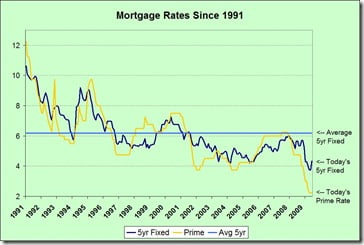“I do think that interest rates will rise, I don't think it will happen in the very near future but three, four, five months from now they will be higher. Definitely a year from now they will be higher. And in two years, they could be notably higher.”
That’s what noted CIBC economist, Benjamin Tal, told the Globe & Mail yesterday. The Globe’s piece questioned whether people have missed the boat on historically-low fixed mortgage rates.
If one had to guess, there’s a good chance that boat has indeed sailed. Perhaps we won’t see 3.50% on a 5-year fixed again for a decade or more. Albeit, no one really knows.
What we do know is that greed can be expensive. Greed makes people wait for rate drops when the trend is clearly up. Greed makes people want something better when today’s rates are absolutely fantastic on a historical basis.
A 5-year fixed mortgage can be had nationally for around 4.35% right now. That’s 1.85% below the average 5-year fixed rate over the last 18 years. (The average is 6.20%, based on 1.5% off posted rates.)

Today’s 4.35% is therefore not a bad boat to catch, especially given the rate risk out there. If the economy rebounds and/or federal budget deficits persist and/or inflation runs up to 3%, five-year fixed rates could easily rise towards their long-term median. It could take a few years, but it’s nonetheless a real possibility. (Click on the above chart to expand it. It shows how rates can easily rise 2% in a typical cycle.)
Given that risk, and given the bargain rates available today, nervous Nellies should keep a tight leash on things.
If you want (or need) to lock in, keep watching 5-year bond yields. If they close above 2.90-3.00%, fixed mortgage rates may rise again.
If bond yields do not break above this level, and there are no new credit market shocks, long-term fixed mortgage rates will probably stay where they are or drift lower.
That’s what it all comes down to in the short-term. Mind you, there’s also the long-term to think about. In the long-term, the bond market is full of headfakes and predicting interest rates long-term is like forecasting the temperature of Christmas 2010. There’s also a host of other factors to consider, like your current mortgage terms and financial situation. This is where good professional advice pays off.
_____________________________________________________
Sidebar: The first chart above plots rates back to 1991. 1991 was a key turning point in monetary policy because the Bank of Canada adopted explicit targets for inflation reduction. Since then, rates have been on a long-term downtrend. Some people like to include the 1980’s in rate comparisons but doing that is rather dubious. Most economist would argue that the catalysts for 80’s-style 20%+ interest rates no longer exist. Therefore, we’ve decided not to inflate our average interest rates with 80’s data and skew the comparison.








Rob, Thank You so much for helping me to understand this stuff. It empowered me enough to shop around until I was offered the rate I wanted. You, your website, and knowledgeable posters are a wealth of information. When my family and friends asked me how I got the rate I did, I told them from you, because I could not have gotten that rate on my own without the confidence your website gave me to ask for better. I have recommended your website to coworkers, friends and family. Have a good day.
Hi Cora, That is really kind of you to say. Melanie and I both truly appreciate it.
Cheers,
-rob
Greed:
It’s just human nature I guess. We get disappointed when we can’t pick the bottom, or the top, of any market.
Thanks for hammering this home RM. Can you “rinse and repeat” with BoC targets and posted variable rates? I’m seeing prime + 0.25 out there now, which seems like a pretty good place to be. (2% less than good 5yr fixed rates!)
-David
Hi David, is prime + .25 in Alberta or just Ontario, can you please identify which lender is giving it, thanks.
I am about 1 yr into a 5 yr mortgage (open) with prime -0.40%. (so at 1.85 currently) at this time. Do I lock in at 3.50% for the last 4 yrs or should I just continue with prime minus 0.4%?
Great site. My one observation is that readers looking to buy a house/condo (not re-financing) should remember there are other factors than just the mortgage. You might not get a mortgage at 5 years fixed at this rate for a long time BUT the house might be 5% less a year from now. If it is then holding off despite mortgages rates going up may be a good thing. Just remember to do all your calculations before deciding.
I have 4 years left on an open variable at prime-.75% (1.5%), so I decided to stay the course. With my $330K+ mortgage, I am saving too much right now on interest charges compared to locking in (even at below 4% 5yr fixed rates which were offered up until 2 weeks ago).
I figure that since I am making extra mini lump sums payments into my mortgage on a semi-monthly basis, it will be more beneficial to stay the course and lock-in a year (or later) when my mortgage is under $300K.
In the end, it’s all about the math, with many uncontrollable factors coming into play. I decided to take the risks that come with my current situation and take advantage of the low prime rate while it lasts.
Mike:
You are (probably) right for people looking to buy an investment property. However, for people looking to replace their home, then the monthly cost of where they live is also an important consideration. (However, as has already been said on other threads: don’t buy more house than you need in a home …)
I have 3 years left on a 5 year fixed mortgage a about 5%. I would like to early renew/blend and extend to both take advantage of the current low rates and protect against much higher rates 3 years from now. To be clear, what I am looking for is a rate that is the average of 3 years at my origianl rate and 2 years at the going 5 year rate.
The Royal Bank does not want to do this without treating this as breaking the mortgage early and wanting IRD penalties paid.
Does it make sense that they are being this inflexible.
Eric – Regardless of what you’re trying to do, there is one thing that is happening: You’re breaking a contact.
When contracts are broken, someone is looking for compensation. How would you feel if the guy who invested the money at the bank for 5yrs decided he wanted it back and you had to sell your house because that’s the money you’re borrowing?
With most lenders, IRD penalties don’t even cover the true cost.
You should just relax… Just like with investments, it’s been proven that you can’t time the mortgage markets. Who knows, renewal rates in 2012 might be waaaaay better than in 2014 (if you break your current term). You’ll make up the difference over your full amortization.
Eric,
If you want there is a way to reduce penalty and take advantage of lower rates.
Neek it seems you read Erics question differently than mine. He is not so much breaking the contract as he is extending it. Notice that he would still be paying the current rate for 3 years and then extending it by 2 more years.
Eric – I am as surprised as you, I did the exact same thing in the past with Scotiabank – Blend and Extend didn’t cost me any penalties.
In light of the rising rates in the future, I was offered (pre-approval) a 3-yr fixed at 3.15% and a 5-yr fixed at 3.69%. What would be the best option for my first home purchase? Thanks!
I had a fixed at 4.6 since 2005. My broker now gave me a prime +.70 variable open. Should I insist a 5 year fixed again?
Thanks
Hi Roje, It depends why an open was recommended to you. There are numerous considerations that go into selecting a suitable term. This is a tough question to answer based on the limited information provided. You can always call another mortgage planner or drop us a line if you’d like a second opinion. Cheers, – Rob